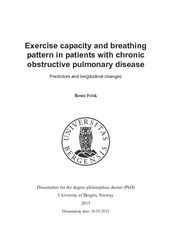| dc.contributor.author | Frisk, Bente | en_US |
| dc.date.accessioned | 2015-08-24T11:43:02Z | |
| dc.date.available | 2015-08-24T11:43:02Z | |
| dc.date.issued | 2015-05-26 | |
| dc.identifier.isbn | 978-82-308-2637-9 | en_US |
| dc.identifier.uri | https://hdl.handle.net/1956/10342 | |
| dc.description.abstract | Chronic obstructive pulmonary disease (COPD) is a progressive lung disease characterized by expiratory flow limitation. The knowledge about factors contributing to the long-term changes in exercise capacity and breathing pattern in terms of the relationship between tidal volume (VT) and minute ventilation (V̇ E) in COPD is scarce. This thesis deals with issues related to long-term changes in exercise capacity and breathing pattern in COPD and potential predictors for the changes. The thesis is based on three studies. Study I was a 3-years prospective cohort study, including 389 patients with COPD in Global Initiative for Chronic Obstructive Lung Disease (GOLD) stages II-IV. We examined predictors for the longitudinal change in six-minute walking distance (6MWD). Study II was a cross-sectional study, including 63 COPD patients performing a cardiopulmonary exercise test (CPET) on treadmill. We aimed to study if a quadratic equation (VT = a + b·V̇ E + c· V̇ E 2) could describe the breathing pattern in terms of the relationship between V̇ E and VT during incremental exercise in COPD. Study III was a longitudinal cohort study, were the 63 COPD patients performed two CPETs with a mean time of 4.5 years between the tests. The longitudinal changes in peak oxygen uptake (V̇O2peak) and breathing pattern as well as potential explanatory variables of change were examined. The 6MWD decreased significantly during the observation period in GOLD stage III (B= −36, 95 % Confidence Interval (CI): -51 to -7, p=0.009) and IV (B= −79, 95 % CI: −125 to −20, p=0.007), while patients in GOLD stage II maintained their walking distance. Predictors for the longitudinal change in 6MWD were self-reported hard physical activity and FEV1. The fraction of subjects performing hard physical activity at three years was higher in those who had participated in a pulmonary rehabilitation program during the observation period, odds ratio 2.4 (95 % CI 1.4−4.2, p=0.001). In Study II we found that a quadratic model could describe the relationship between V̇ E and VT in 59 of 63 COPD patients (p<0.05) and the linear coefficient (b) was negatively (p=0.001) and the quadratic coefficient (c) positively (p<0.001) related to FEV1. In Study III, V̇O2peak and FEV1 deteriorated significantly during follow-up. The reduction in V̇O2peak was related to baseline V̇O2peak (p<0.001), the changes in resting inspiratory capacity (IC) (p=0.005) and FEV1 (p=0.031), age (p=0.023) and smoking during follow-up (p=0.021). A higher baseline V̇O2peak, a larger decrease in IC and FEV1 and higher age were associated with a larger reduction in V̇O2peak. The quadratic model described the relationship between V̇ E and VT in 61 of 63 patients at CPET1 and at 59 of 63 patients at CPET2. The linear coefficient (b) increased (p=0.007) and the quadratic coefficient decreased significantly (p=0.002) from CPET1 to CPET2. Maximal VT was achieved at a lower V̇ E. The changes in the curve parameters were all related to the change in FEV1. We have concluded that exercise capacity deteriorates over time in COPD, and that the longitudinal change is related to the decline in lung function. Persistent smoking is associated with a larger decline, while high habitual physical activity is associated with a lower decline in exercise capacity. The longitudinal change in breathing pattern is associated with the reduction in lung function. Any relationships between exertional dyspnea and changes in breathing pattern need further studies. | en_US |
| dc.language.iso | eng | eng |
| dc.publisher | The University of Bergen | eng |
| dc.relation.haspart | Paper I: Frisk B, Espehaug B, Hardie JA, Strand LI, Moe-Nilssen R, Eagan TM, Bakke PS, Thorsen E. (2014): Physical activity and longitudinal change in 6-min walk distance in COPD patients. Respir Med. Jan;108(1):86-94. The article is not available in BORA due to publisher restrictions. The published version is available at: <a href="http://dx.doi.org/10.1016/j.rmed.2013.09.004" target="blank">http://dx.doi.org/10.1016/j.rmed.2013.09.004</a> | en_US |
| dc.relation.haspart | Paper II: Frisk B, Espehaug B, Hardie JA, Strand LI, Moe-Nilssen R, Eagan TM, Bakke PS, Thorsen E. (2014): Airway obstruction, dynamic hyperinflation, and breathing pattern during incremental exercise in COPD patients. Physiol Rep. Feb 7;2(2):e00222. The article is available at: <a href="http://hdl.handle.net/1956/8998" target="blank">http://hdl.handle.net/1956/8998</a> | en_US |
| dc.relation.haspart | Paper III: Frisk B, Hardie JA, Espehaug B, Strand LI, Moe-Nilssen R, Eagan TM, Bakke PS, Thorsen E. (2015): Peak oxygen uptake and breathing pattern in COPD patients – a four year longitudinal study. BMC Pulm Med. Aug 19;15:93. The article is available at: <a href="http://hdl.handle.net/1956/10338" target="blank">http://hdl.handle.net/1956/10338</a> | en_US |
| dc.title | Exercise capacity and breathing pattern in patients with chronic obstructive pulmonary disease. Predictors and longitudinal changes | en_US |
| dc.type | Doctoral thesis | |
| dc.rights.holder | Copyright the author. All rights reserved | |
| dc.identifier.cristin | 1244355 | |
| dc.subject.nsi | VDP::Medisinske Fag: 700::Klinisk medisinske fag: 750::Lungesykdommer: 777 | en_US |
